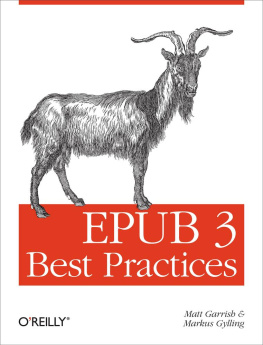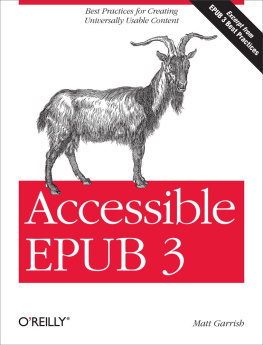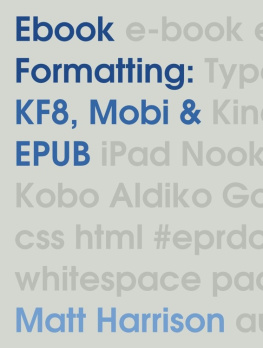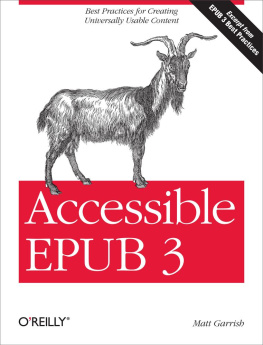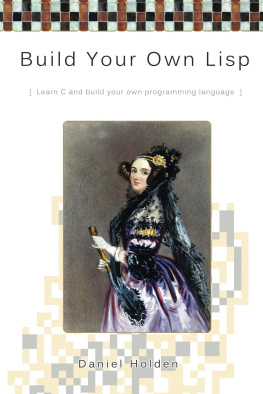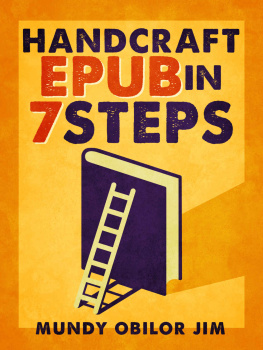Preface
When I first wrote What Is EPUB 3? in the summer of 2011, it was envisioned as both a brief standalone piece that would orient people to the new EPUB 3.0 revision the International Digital Publishing Forum (IDPF) was about to release and also as an introduction to what we hoped would evolve into a larger best practices guidethe one youre reading now.
Youll find that book distilled down to its bare essentials in this books introduction, but if you are new to EPUB, there is much information put into that original guide that is helpful to know before tackling this one, so if I can recommend some advance reading, it would be to grab a copy of that ebook and give it a skim. If youre not familiar with EPUBs generally, or whats changed from 2 to 3, itll help give you a general view of the big picture before launching into the details that well be covering here. Its only a small-chapter-length in size, too (and free!), so it wont take you long to get through, and it will give you a condensed perspective on what an EPUB is.
This guide instead delves right into the EPUB container and walks you through best practices as they relate to production of your publications; youll find a bit of a mixture of practices and guidance on how to use EPUB technologies. You dont necessarily have to know the technology of publishing EPUBs inside and out to find value here, nor do you have to be a programmer or tech geek, but this book is for the ebook practitioner.
In planning out this guide, one of the challenges was trying to keep straight where the boundaries are between EPUB 3 and the technologies it combines under its format umbrella. Can a single book about EPUB 3 best practices try to detail every nuance of HTML5, CSS3, JavaScript, MathML and SVG, just to pick out some of the prime content document technologies? The answer should be obvious, considering the volume of material thats already been written on those subjects.
What weve tried to do in this guide is find the key areas of overlap between those technologies as they relate to publishing. Youre going to find a lot of discussion about all of the features just listed, and more, but if youre just getting started with the technologies used in EPUBs this book will be more of a starting point on your journey. You will learn about potential issues when scripting in the reading system environment, for example, but you wont find a tutorial on the JavaScript language.
Each of the chapters in this book deals with a unique aspect of the creation and distribution process. There is no assumption that youre familiar with the entire format, because the production of EPUBs often involves expertise from a number of different functional areas. The people responsible for ensuring the technology of your ebooks probably arent going to be the same people who are responsible for the metadata. The authors and editors creating the content are likewise not going to be the people bundling and distributing the ebook. So although the book will move over EPUB 3 in a linear fashion, and can be read from cover to cover to learn about production as a whole, each chapter is also intended to be readable in isolation, with pointers forward and back as necessary.
And although we hope youll implement all the best practices you can, the book is not designed to be a checklist to content conformity, and is not written as such. Everyone produces using different methods, and everyone has to work within the constraints of their production workflows, so weve tried hard not to target specific processes or reading systems but stick to the ultimate outcome. If you cant implement every accessibility practice, for example, the hope is that at least youll understand where, and how, you can improve later on down the road.
This guide also isnt intended to be the final word on EPUB, as EPUB is always evolving. Its about preparing you for producing EPUB 3 content using all the features it makes available, helping you avoid known pitfalls, and giving you a heads up on the issues youll face. If successful, it will also hopefully enlighten you to why the specification is defined the way that it is. A specification is just an artifact of agreement on how to implement a technology, after all. It tells you what the creators decided you must and should and may doand not dobut specifications dont spend time retelling you the story of why.
It doesnt mean youll agree with all the decisions that were made, but specifications by nature portray a myth of homogeneity. Its the discussions and debate that continue around EPUB that keep it at the forefront of ebook technologies.
If weve done our job writing this book, you should not have new ideas for your own production, but be well equipped to join in the discussions on the future.
The Future
By the time this book comes out, the EPUB 3 specification will be more than a year old. Its hard to believe how fast time flies, but its not surprising that technology is only just catching up to the standard. That was a goal of the revision after all: to position the specification so that features and best practices could be defined ahead of the pack instead of trying to constantly play the catch-up game.
The modular nature of the specification has also proven its worth. Since the specification was published in October 2011, IDPF subgroups have published two new documents: fixed layouts and advanced adaptive layouts. Work on grammars for marking up indexes and dictionaries has been ongoing since the beginning of 2012, and a new group dealing with hybrid layouts is also in the process of being chartered. The IDPF is continuing to work with its members to evolve the standard to meet their needs; its not sitting on its laurels or creating a format by fiat.
Another major revision of the standard is not on the horizon at this point, but minor revisions are anticipated to add new CSS functionality, fix bugs, and see if consensus can be found on open issues like codecs and metadata. A new minor revision is expected to begin as this book gets readied for print, which will effect the information in this guide, but its anticipated only for the positive.
You may have RDFa and microdata for content documents by the time you read this, for example, or at least a firm promise of them. Fixed layout support could be stronger if the information document its currently defined in gets rolled into the main specification. The HTML5 landscape should be clearer, too, as the W3C pushes to finalize the standard by 2014. EPUB 3 itself also is hoped to become an ISO Technical Specification during the process.
But dont worry that this means youre going to be fed lots of point-in-time ideas. The areas of instability are not that numerous, and the practices that exist solely to deal with them are clearly marked. The point of this book is to look at the core of the standard, so the information should stand for as long as EPUB 3s are being produced.
And even as we began wrapping up this book, a new project to create a conformance test suite for reading systems was announced, which will help standardize rendering across reading systems, more and more of which are appearing that support EPUB 3 content. In natural step, publishers are also announcing their plans to start releasing content (the Hachette Book Group, for example).
EPUB 3 is here, now, in other words.
But were not here for long-winded introductions. Lets get on with the show!
How to Use This Book
Although you can read this book cover to cover, each chapter contains information about a unique aspect of the EPUB 3 format allowing them to also be read in isolation. To simplify jumping through the content, heres a quick summary of the information in each:

